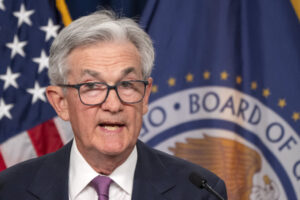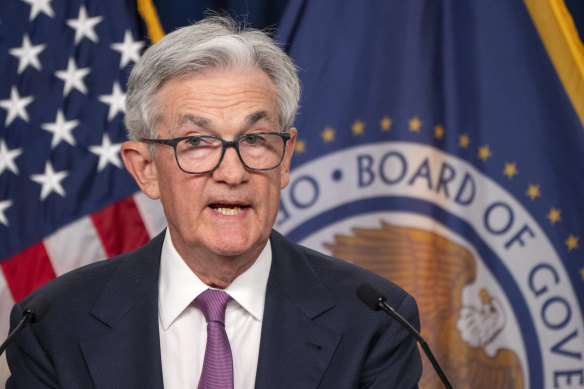Fed raises interest rates to 22-year high, leaves door open for more hikes

Save articles for later
Add articles to your saved list and come back to them any time.
The Federal Reserve raised interest rates to the highest level in 22 years and Chair Jerome Powell said additional increases will depend on incoming data as officials fine-tune their effort to further quell inflation.
The quarter percentage-point hike, a unanimous decision, lifted the target range for the Fed’s benchmark federal funds rate to 5.25 per cent to 5.5 per cent, the highest level since 2001. It marked the 11th increase since March 2022, when the rate was near zero.
’We’re going meeting-by-meeting”: Jerome Powell said more increases this year are possible.Credit: AP
“Looking ahead, we will continue to take a data-dependent approach in determining the extent of additional policy firming that may be appropriate,” Powell said at a post-meeting press conference.
That echoed what the central bank’s Federal Open Market Committee said in a statement published Wednesday in Washington, which overall was almost identical to its previous statement in June.
“The committee will continue to assess additional information and its implications for monetary policy,” policymakers said. “In determining the extent of additional policy firming that may be appropriate to return inflation to 2 per cent over time, the committee will take into account the cumulative tightening of monetary policy, the lags with which monetary policy affects economic activity and inflation, and economic and financial developments.”
Wall Street edged lower after the announcement before rising. The S&P 500 was 0.2 per cent higher in late trade, while the Dow Jones is flat and the Nasdaq lost 0.5 per cent.
Powell said the data could justify either holding rates steady or raising them again at the Fed’s next meeting in September. He said policymakers haven’t made any decisions about future moves, including whether they are now inclined to raise rates at every other meeting.
“We’re going to be going meeting-by-meeting,” he said.
Treasury yields fell, the S&P 500 index pared the day’s losses and the dollar slid.
Swaps traders held fairly steady the probability they see of the Fed hiking rates by an additional quarter point before year’s end. The pricing implies just slightly over 50 per cent chance of another bump higher before the Fed tightening cycle ends.
The Fed has since early last year engaged in the most aggressive tightening campaign since the 1980s in an effort to curb inflation, which in 2022 hit a 40-year high. While policymakers paused rate hikes last month to assess the impact of previous moves, they also signalled at the time that two more increases would probably be appropriate by the end of the year.
The latest hike was widely anticipated after recent reports showed a resilient economy that has largely withstood higher interest rates so far. But ahead of Wednesday’s decision, investors saw a second increase as less certain, in part because of data on consumer prices showing inflation receded sharply last month.
Assessment upgraded
The FOMC in its statement repeated its description of inflation as “elevated,” and upgraded its description of economic growth to “moderate” from “modest.” It reiterated that the banking sector is “sound and resilient,” while cautioning that credit tightening is expected to weigh on the economy following the failures of three US regional banks earlier this year.
While June’s consumer-price report showed inflation decelerating to 3 per cent from last year’s 9.1 per cent peak, policymakers have expressed concern about so-called “core” inflation, excluding food and energy, which has been slower to come down. They have singled out service-sector inflation in particular as a category they believe remains elevated due to tight labor markets.
Fed officials have also been surprised by the resilience of economic growth. Forecasters expect a quarterly report on gross domestic product due on Thursday to show the US economy expanded by an annualised 1.8 per cent in the April to June period. Some Wall Street economists have pushed back calls for a recession this year in light of the ongoing strength in economic activity alongside receding price pressures.
The FOMC next meets on September 19-20 and subsequently on October 31-November 1. Powell will also have an opportunity to clarify the central bank’s view on the future path of rates at the Kansas City Fed’s annual symposium in Jackson Hole, Wyoming, in late August.
Bloomberg
The Market Recap newsletter is a wrap of the day’s trading. Get it each weekday afternoon.
Most Viewed in Business
From our partners
Source: Read Full Article

